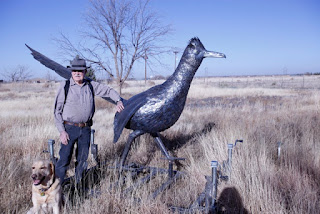 |
| R. G. Box, Biscuit and Rowdy, with City of Lubbock in Background |
I think it is time that I removed the mystery from the strange happenings in the cotton field south of Lubbock. My friend, R. G. Box, is doing all that hammering out in his smithy, next to the spreading Mesquite Tree. He has built, with his large and sinewy hands, a monument to excellence, patience and perseverance.
R. G. and his companion, Biscuit, walk out to his blacksmith shop at six-thirty each morning and fire up the forge. He stops at noon for a short time, to eat lunch and rest a while, then returns and works until about dark. Sometimes, he rests on Sundays, but sometimes his work is so compelling he cannot skip an hour, much less a whole day. A lot of people may work that hard, but most of them are not 77 years old.
Mr. Box works with tools and methods dating from the 1800’s. His main forge was originally built in 1893. He restored the forge and mated it with an overhead bellows built in 1890. He keeps a pot of coffee on a 1912 wood stove made in Michigan. His 450 pound anvil was made in Denmark in 1903 and still performs superbly—it’s hard to break an anvil and they just don’t wear out.
R.G. keeps all this equipment in his shop, a sheet metal building fifty yards from his home near Lubbock. Forty years ago, he bought a few acres in the corner of a cotton field, fenced it, planted seven hundred pecan trees and then moved to Colorado. He planned to return to the Lubbock area and retire in the shade of those trees and live off his pecan crop. He named the place Pecanderosa, with a nod to the then-popular TV show, Bonanza.
Sitting in the shade and cracking pecans did not suit R.G., so he set about to build the Pecanderosa Forge, a blacksmith shop, to give himself something to do. He sold mature pecan trees to local nurseries to help with expenses and started to learn the art of forging iron. His work slowly moved past the point of welding and simple blacksmithing and into the realm of metal art.
For the past eleven months, R.G. has been working on a six foot tall, eleven foot long roadrunner that may become the mascot for the University of Texas at San Antonio. If so, it will be called “Rowdy.” The creature weighs nearly 850 pounds and is mounted on a platform that will facilitate relocation. The original plan was to move Rowdy to the Alamo Dome for each football season, then back to the campus for the rest of the year. Delivery has been planned for early 2012, after a proper site is prepared.
Rowdy is complete now, finished with 962 individual feathers, each cut out of steel plate and forged by hand, hammered into life on that 1903 anvil. Each feather was fitted and shaped to its specific position on the roadrunner’s body, then welded into place. All the welds are concealed beneath adjacent feathers. The sculpture that resulted from all this care is spectacular. It is truly one of a kind and cannot be duplicated by simply re-casting as is done with bronze sculptures.
No matter where Rowdy ends up, it is a work of art created by a master craftsman. R.G. Box dedicated himself to breathing life into the sculpture and it will be admired for many years by everyone who sees it. Even for a Lubbock boy, R.G. found a unique way to use up a year.
To learn more about Mr. Box and his work, go to pecanderosaforge.com and spend some time in the last century with a unique individual---and his faithful companion, Biscuit.


No comments:
Post a Comment